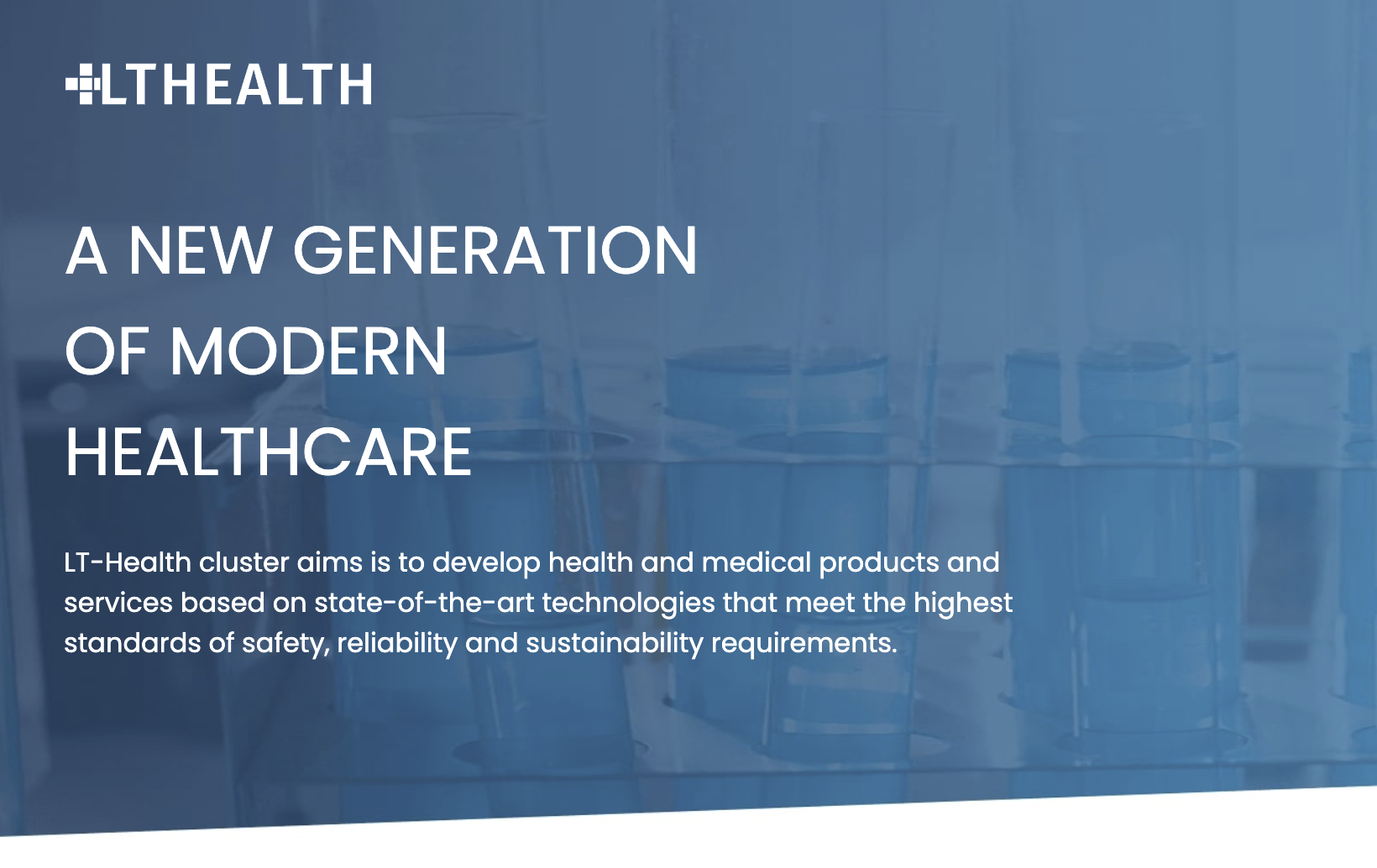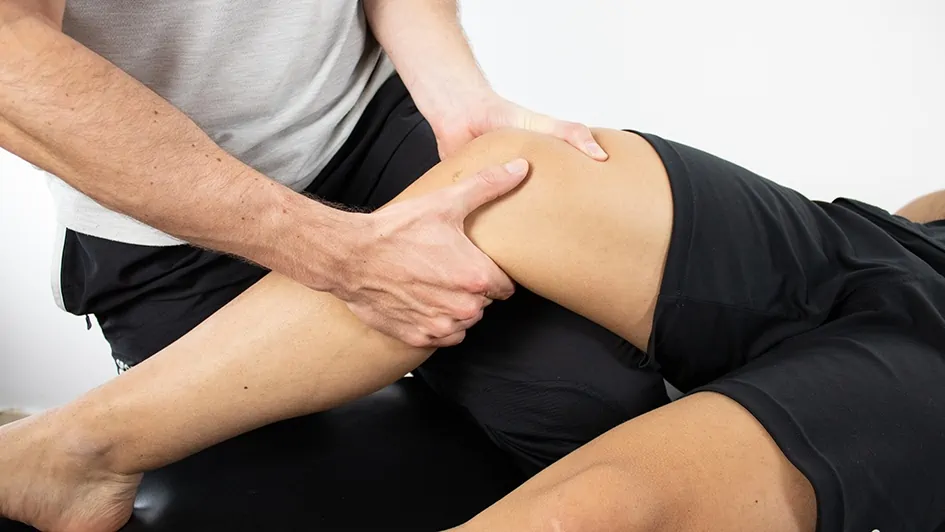I. ACL Injury Landscape in the Football (NFL)
In the high-stakes world of the National Football League (NFL), anterior cruciate ligament (ACL) injuries represent a formidable challenge, not only due to their frequency but also because of the significant impact they have on players’ careers, teams’ performance, and the financial implications for franchises. ACL Injuries in Football/NFL are among the most common and severe injuries, with a considerable number of players experiencing these injuries each season, leading to extensive rehabilitation periods and, in some cases, altering the trajectory of careers. The mechanism of these injuries, often involving non-contact scenarios such as sudden deceleration, changes in direction, or landing from a jump, underscores the unpredictable nature of the sport and the inherent risk players face every time they step onto the field.
In response to the pressing need for precise diagnosis, effective treatment, and comprehensive prevention strategies, the adoption of advanced diagnostic tools such as arthrometers—specifically, the DYNEELAX® and GNRB®—has emerged as a critical evolution in sports medicine. These devices offer unparalleled accuracy in assessing the integrity of the ACL, providing objective data that is crucial for determining the appropriate course of action following injury. Beyond diagnosis, arthrometers play a pivotal role in the rehabilitation process, offering measurable benchmarks for progress and aiding in the critical decision-making process regarding a player’s readiness to return to play.
This article sets out to explore the multifaceted impact of ACL injuries within the NFL, highlighting the invaluable role that cutting-edge technologies like the DYNEELAX® and GNRB® arthrometers play in this context. By offering objective, quantifiable data, these tools not only facilitate a more accurate and timely diagnosis but also significantly contribute to the development of personalized treatment and rehabilitation plans. Ultimately, the integration of arthrometers into the management of ACL injuries holds the promise of not just mitigating the immediate effects of these injuries but also paving the way for more effective prevention strategies, potentially safeguarding the careers of NFL athletes and ensuring their swift and safe return to the field.
This article will answer questions like:
The Anterior Cruciate Ligament (ACL) injury represents one of the most formidable challenges within the National Football League (NFL), both in terms of player health and team strategy. The ACL is crucial for knee stability, essential for the dynamic and high-impact movements inherent in football. When it comes to understanding the scope and impact of these injuries, several studies provide invaluable insights.
1.1 What causes ACL injuries in Football/NFL?
In American football, movements such as cutting and pivoting apply substantial stress on the knee. The Anterior Cruciate Ligament (ACL)’s role is pivotal in preserving the knee’s stability against these forces. Injuries frequently occur when a player fixes their foot to the ground and attempts to change direction, placing their body weight on that foot. This results in a rotational force on the knee joint that the ACL must withstand. If the ACL is unable to handle this stress, it can lead to a tear.
1.2 Background of ACL injuries in Football/NFL
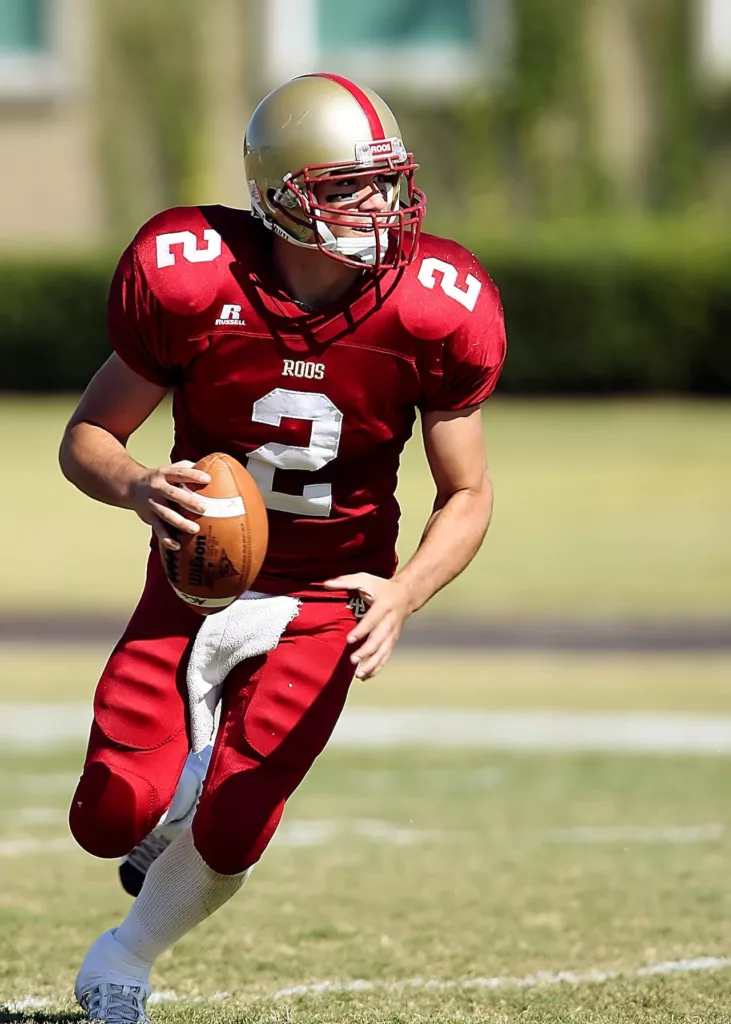
A pivotal piece, “Epidemiology of Anterior Cruciate Ligament (ACL) Tears in the National Football League,” by Palmeri-smith et al. (2021) (1) sheds light on the incidence and patterns of ACL injuries, highlighting their prevalence and the substantial effect they have on players’ careers and team success. This research underscores the critical nature of ACL injuries, signaling them as a significant concern for teams, affecting player availability and longevity in the sport.
Another critical study, “ACL Tears in the National Football League From 2013 to 2020,” by Allahabadi et al. – 2022 offers a closer look at recent trends, particularly noting an increased proportion of in-season ACL tears during the 2020 season, possibly linked to the early COVID-19 pandemic’s unique circumstances and the adjustments in preseason preparations. The study’s findings suggest that changes in preparation schedules and the intensity of play could influence injury rates, pointing towards the need for adaptive training and prevention strategies.
1.3 Common Mechanisms and Consequences
ACL injuries occur through contact and non-contact mechanisms. A 2023 systematic video review in the NFL highlighted that deceleration, changes in direction, and awkward landings are prevalent non-contact mechanisms. At the same time, direct impact to the knee often results in contact injuries (3). Furthermore, Epidemiological studies like Dodson et al. (2016) (4) and Palmeri-smith et al. (2021)(1) underscore these injuries’ prevalence and patterns, revealing positions like defensive backs and wide receivers as most susceptible, given their high-speed maneuvers.
The prevalence of ACL injuries in the NFL calls for an ongoing evaluation of injury mechanisms, prevention strategies, and recovery protocols to safeguard player health and optimize team performance. Through detailed analyses and the application of sports medicine advancements, teams can better navigate the challenges posed by ACL injuries, enhancing both player welfare and on-field success.
1.4 How are football ACL injuries diagnosed nowadays ?
For diagnosing an ACL injury, both an MRI and a physical examination are commonly employed together. The MRI is highly valued for its precision in revealing the injury’s severity, allowing doctors to quickly understand the damage’s structure. Additionally, assessing the ACL’s functionality necessitates specific physical tests, such as the Lachman test and the pivot shift test. These examinations require the patient to relax the tested joint, a challenge when dealing with the discomfort of a newly injured knee.
1.5 Challenges and Limitations of Traditional Diagnostic Methods
Traditional methods for diagnosing ACL injuries, including physical examinations and standard imaging techniques like MRI, face limitations. These methods can miss signs of early ACL strain or partial tears, leading to underdiagnosis or misdiagnosis. The subjective nature of physical exams can result in diagnosis variability, depending on the examiner’s expertise. For instance, the problem of blood being present in the joint, a common occurrence following an injury, can complicate the interpretation of physical signs and imaging results, further challenging accurate diagnosis.
1.6 Importance of Precise, Early Diagnosis & the Use of Innovative Technologies
The precision and timing of an ACL injury diagnosis are paramount for optimizing treatment outcomes and guiding effective rehabilitation strategies. Early and accurate identification enables tailored treatment plans, significantly improving the prognosis for return to play and minimizing re-injury risks. This necessitates advanced diagnostic tools that provide objective, quantitative data on the ACL’s integrity and surrounding structures.
Advanced diagnostic modalities, including arthrometers such as DYNEELAX® and GNRB®, offer a significant advancement by providing precise measurements of knee laxity and the functional status of the ACL. These technologies not only enhance diagnosis accuracy (Better diagnosis of partial ACL ruptures compared to MRI – Cojean et al. – 2023 (5)) but also offer valuable insights throughout the rehabilitation process (Nouveau et al. – 2017 (6)), ensuring a data-driven approach to managing ACL injuries in NFL athletes.
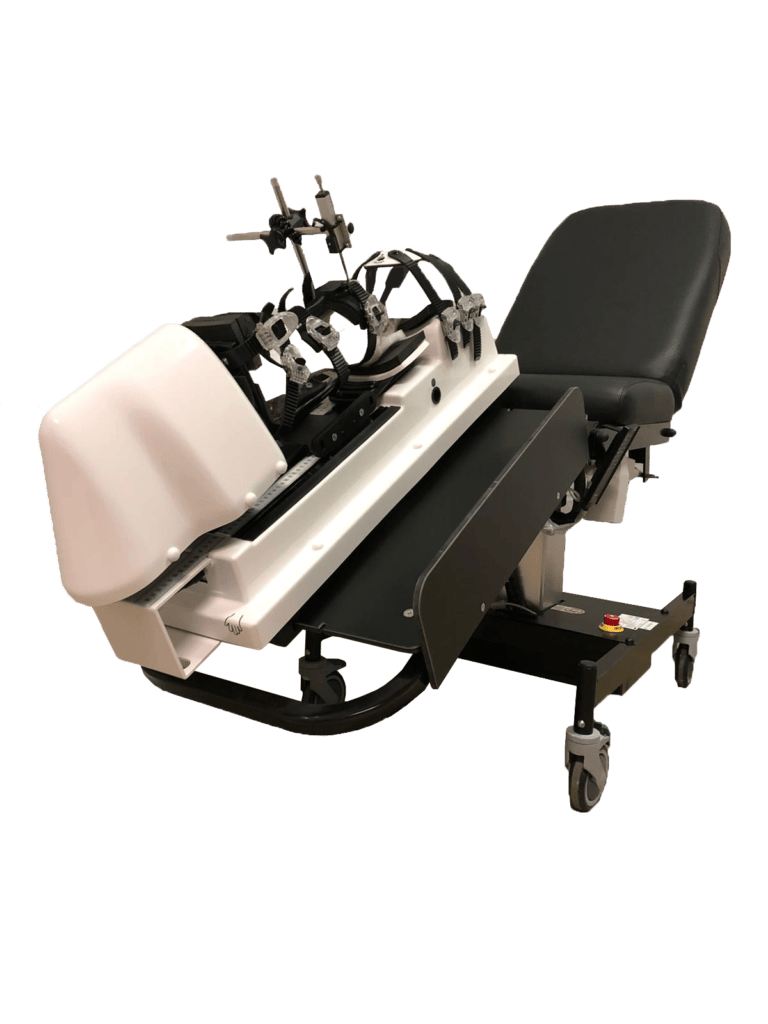
Understanding ACL injuries’ intricacies in the NFL—from their mechanisms to diagnosis challenges—highlights the value of advanced diagnostic technologies. These tools promise to revolutionize ACL injury management, facilitating early detection, informed treatment decisions, and evidence-based criteria for safe return to play.
II. Impact of ACL Injuries on Players and Teams
The impact of Anterior Cruciate Ligament (ACL) injuries within the National Football League (NFL) extends far beyond the acute rehabilitation period, affecting players’ career longevity, team dynamics, and the financial health of the franchises involved. The multifaceted nature of these injuries demands a comprehensive understanding, integrating clinical insights with economic analyses and team performance evaluations.
2.1 Career Longevity and Performance Impact
ACL injuries are among the most dreaded in sports, given their potential to significantly alter an athlete’s career trajectory. The rigorous demands of rehabilitation and the psychological toll of recovery can influence a player’s return to peak performance. According to the study “Return to Play and Performance After Anterior Cruciate Ligament Reconstruction in National Football League Players,” by Mody et al. in 2022 (7), a substantial percentage of athletes successfully return to play, but their performance metrics pre- and post-injury reveal a nuanced picture of recovery. This evidence highlights the critical role of advanced, tailored rehabilitation programs designed to address not only the physical but also the psychological aspects of recovery.
2.2 Economic Implications for NFL Teams
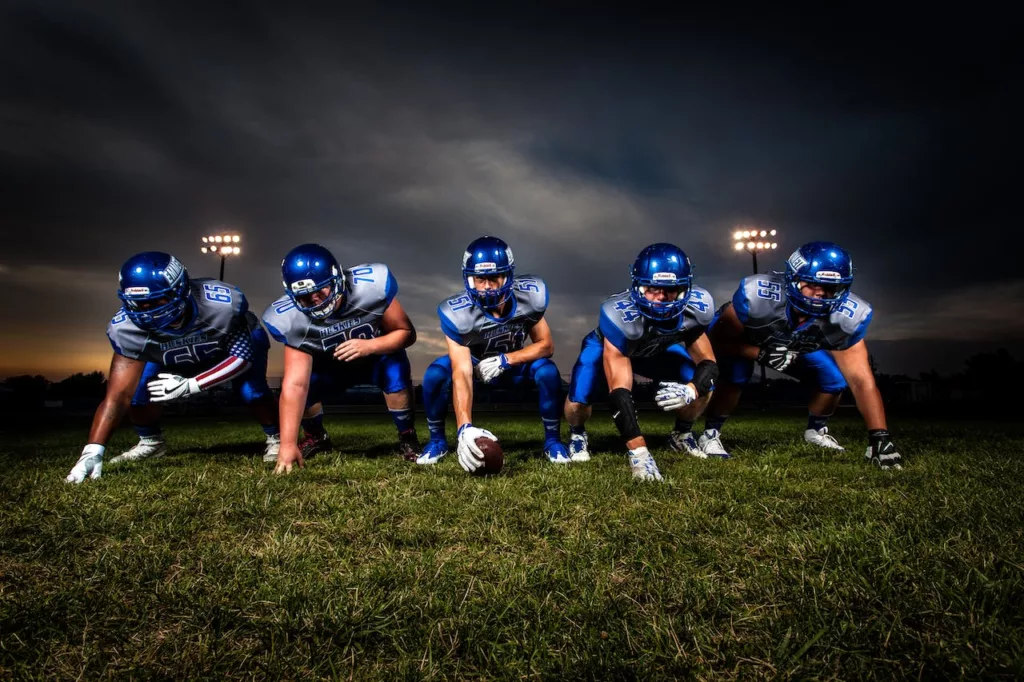
The economic implications of ACL injuries for NFL teams are profound. From the direct costs associated with surgery and rehabilitation to the indirect costs related to lost player time and potential impacts on team success, the financial burden is significant. Furthermore, the study “Recurrent Anterior Cruciate Ligament Tears in the National Football League: A Case-Control Study” by Stuhlman et al. – 2019 (8) underscores the heightened risk of reinjury, adding another layer of financial complexity for teams managing long-term player health and contract decisions.
2.3 Strategic Challenges and Team Performance
The absence of key players due to ACL injuries forces teams to adapt their strategies and often reshuffle their line-ups, which can disrupt team cohesion and performance continuity. The epidemiological insights provided by “Epidemiology of Anterior Cruciate Ligament Tears in the National Football League” by Riann M Palmieri-Smith – 2021 (1) offer a broader understanding of injury patterns, potentially informing more effective prevention strategies and minimizing their strategic impact.
2.4 Advancing ACL Injury Management
The integration of scientific research into clinical practice has been pivotal in advancing ACL injury management. Systematic reviews and meta-analyses, such as those examining the efficacy of injury prevention programs, provide evidence-based guidelines that can reduce injury rates and improve recovery outcomes. These comprehensive analyses not only inform clinical decision-making but also offer valuable insights for team management in developing robust injury prevention and management protocols.
2.5 Future Directions
As the body of research on ACL injuries continues to grow, the incorporation of innovative arthrometers for diagnostic tools, rehabilitation techniques, and injury prevention strategies will be critical in mitigating the impact of these injuries on players and teams alike. The evolution of sports medicine, fueled by ongoing studies and technological advancements, promises to enhance our understanding and management of ACL injuries, ultimately benefiting the athletes, teams, and the broader NFL community.
ACL injuries in the NFL present complex challenges that span the medical, economic, and strategic domains. Addressing these challenges requires a multifaceted approach, leveraging the latest research and technological advancements to optimize injury management and prevention strategies. By doing so, the NFL can continue to enhance player safety, team performance, and the overall sustainability of the sport.
III. Advances in ACL Injury Diagnosis and Monitoring
The introduction of arthrometers, specifically DYNEELAX® and GNRB®, has revolutionized the diagnostic landscape for Anterior Cruciate Ligament (ACL) injuries, offering a precise, non-invasive means of assessing knee ligament integrity. These devices leverage advanced biomechanical testing to quantify knee laxity and stiffness, providing an objective measurement that surpasses the subjective assessments traditionally used in clinical settings.
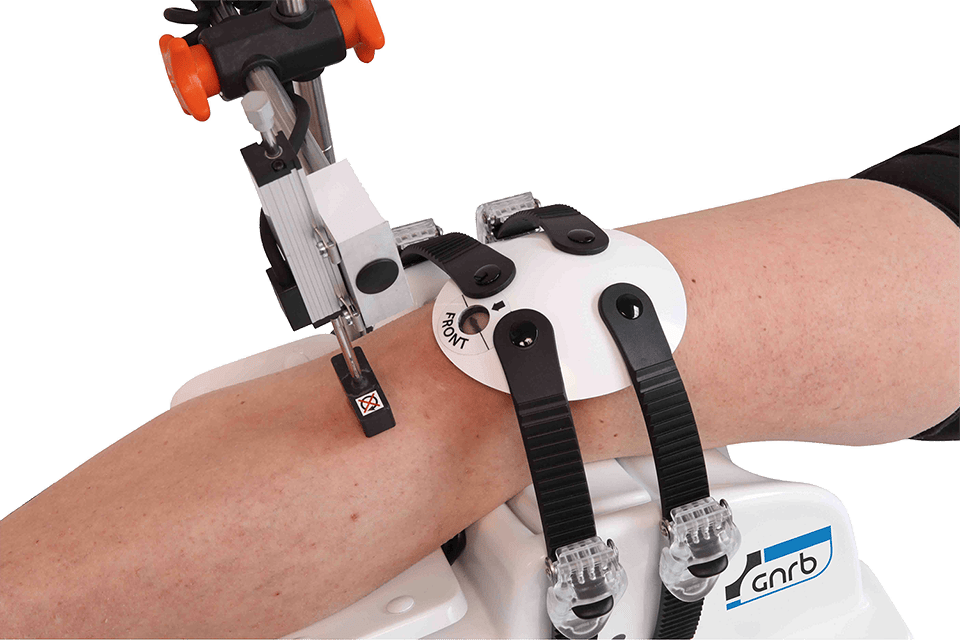
3.1 Arthrometer Technology and Advantages
DYNEELAX® and GNRB® operate on the principle of applying controlled forces to the knee and measuring its response, thereby assessing the ACL’s functional status. The GNRB, as detailed in the 2023 study by Théo Cojean (5), employs a robotic system to apply a reproducible anterior tibial translation with respect to the femur, measuring the knee’s resistance to this movement, which is indicative of the ACL’s integrity. It has been proven that partial ACL ruptures are better diagnosed with DYNEELAX® and GNRB® arthrometers than with MRI in the 2023 study of Cojean et al. (5). Similarly, Dyneelax extends this capability of objectively measuring translation by also analyzing rotational knee laxity, a critical aspect of knee stability that traditional tools cannot accurately assess (Read 2023 Dyneelax Review from Cojean et al.)(9). It should be noted that the idea is not to replace MRI, but instead use both analysis to (Static analysis of MRI and Dynamic analysis of Dyneelax). Both tests are indeed very complimentary with one another.
These arthrometers’ advantages over traditional assessment methods are manifold. They provide quantifiable, repeatable results that eliminate the inter-observer variability inherent in manual testing. Studies, including those by Klouche in 2015 (10) and Kayla Smith in 2022 (11), have underscored their diagnostic value and reliability, marking a significant advancement in our ability to diagnose ACL injuries accurately.
3.2 Injury Diagnosis and Ligament Laxity Monitoring
The early diagnosis of ACL injuries is critical for effective intervention, and here, arthrometers shine. They enable the identification of subclinical laxity changes that might not yet manifest in symptoms or be detectable through imaging studies, as highlighted in Magdic’s 2023 study (12) on the intra-rater reliability of the GNRB arthrometer. This early warning system allows for preventative measures to be taken before a full-blown injury occurs.
During rehabilitation, the journey from injury to return-to-play is fraught with uncertainties. Utilizing arthrometers for monitoring rehabilitation progress provides objective data to guide this process. Studies, such as those by Nouveau in 2017 (6) and Semay in 2016 (13), have illustrated how regular GNRB assessments can track changes in knee laxity over time, offering a clear picture of the graft’s integration and the knee’s return to stability post-ACL reconstruction.
3.3 Making Informed Return-to-Play Decisions
Perhaps the most critical phase in ACL injury management is the decision to return an athlete to play. The subjective nature of traditional assessments often makes this a challenging call. However, with arthrometers, decisions can be grounded in objective data. By establishing baseline measurements and comparing them throughout the recovery process, practitioners can make informed decisions about a player’s readiness to return to the field, potentially saving millions for sports organizations by preventing premature returns and subsequent re-injuries. Regarding Return-To-Play (RTP), a study was conducted in 2023. Forelli’s 2023 exploration of post-operative rehabilitation (14) underscores the importance of objective measurements in determining when it’s safe for athletes to resume high-level activities.
DYNEELAX® and GNRB® arthrometers offer a comprehensive solution for diagnosing, treating, and preventing ACL injuries. Their ability to provide precise, objective data marks a significant leap forward in managing one of the most challenging injuries in sports medicine today.
IV. Prevention and Early Detection in football (NFL)
4.1 How do you prevent football ACL injuries at present?
A significant number of non-contact injuries can be mitigated through targeted exercise programs that emphasize balance, strength, and plyometrics. Exercises like planks, Nordic hamstring curls, and squats are particularly effective. For athletes, it’s crucial to possess not only an awareness of their limbs’ positions in space but also the strength to swiftly adjust their positioning to a safer state, thereby preventing injury. This combination of spatial awareness and rapid, controlled movement is key to reducing the risk of such injuries. To further enhance injury prevention and assessment, the use of arthrometers like DYNEELAX® or GNRB® offers a sophisticated tool for accurately measuring joint stability and movement, providing valuable insights into knee health and function.
4.2 Enhancing Prevention with Robotic Arthrometers
The strategic implementation of pre-season and in-season testing protocols with arthrometers like DYNEELAX® and GNRB® is pivotal in identifying NFL players at higher risk of ACL injuries. This approach leverages the advanced diagnostic capabilities of these devices to facilitate early detection and intervention, potentially averting injuries that could sideline players for extended periods.
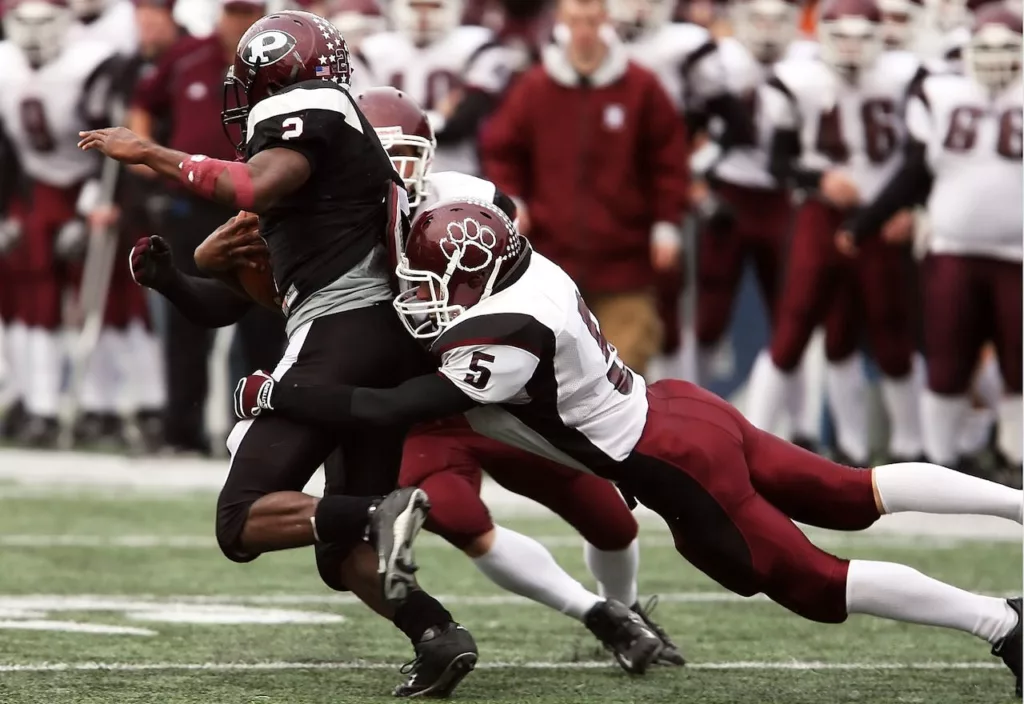
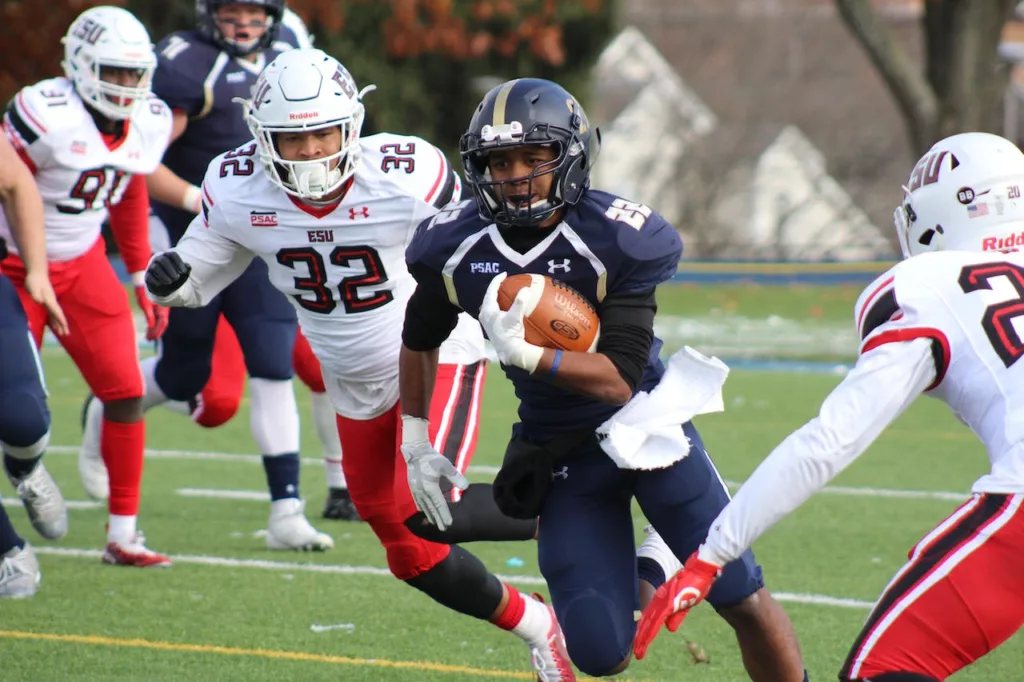
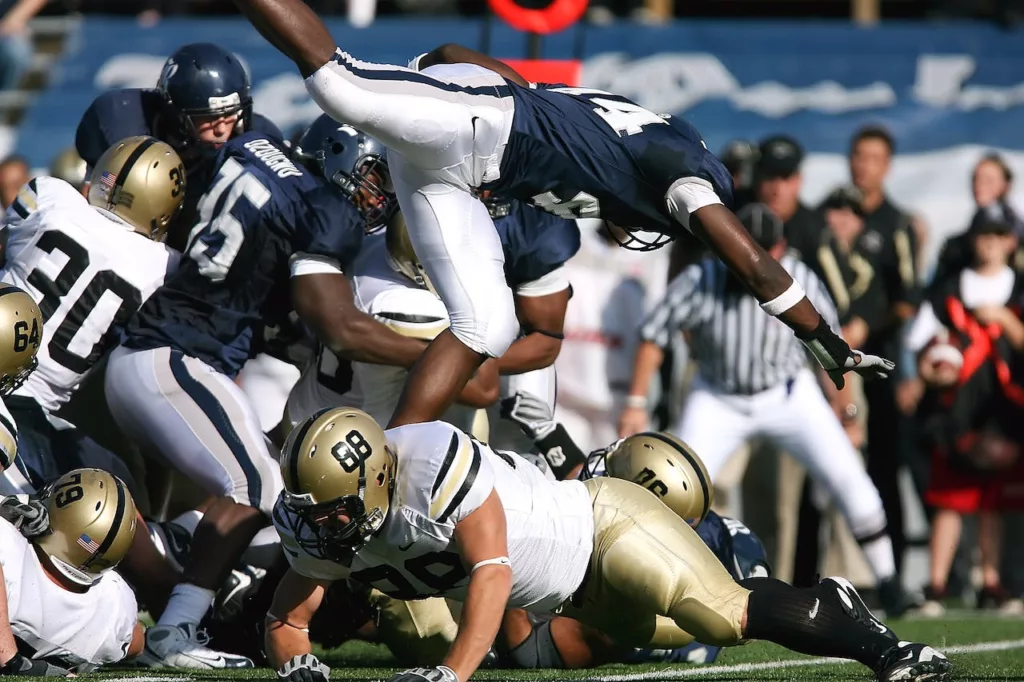
4.2.1 Pre-Season Testing Protocols
Pre-season testing protocols serve as a benchmarking tool, establishing baseline knee stability and ligament integrity measurements for each player. These baselines are critical for tracking changes over time, which could indicate increased risk for ACL injuries. Studies, including those by Klouche et al. (2015)(10) and Kayla Smith (2022)(11), have demonstrated the utility of the GNRB arthrometer in accurately assessing ligament laxity, providing a quantifiable method to gauge injury risk prior to the season’s start.
4.2.2 In-Season Monitoring
In-season monitoring allows medical staff to continuously assess players’ knee stability, identifying any deviations from their pre-season baselines. This proactive surveillance can pinpoint early signs of ligament wear or damage, enabling timely intervention. Magdic’s et al. 2023 study (12) on the intra-rater reliability of the GNRB arthrometer underscores the precision these devices offer in repeated assessments, ensuring that shifts in knee laxity are accurately captured and addressed.
4.2.3 Early Detection and Intervention
The cornerstone of preventing ACL injuries lies in the early detection of potential ligament damage before it progresses to a full tear. Theo Cojean’s 2023 study (5) comparing MRI findings with GNRB measurements highlighted the latter’s capability in detecting subtle changes in ligament properties, potentially identifying at-risk ligaments before traditional imaging techniques. Early intervention strategies, such as targeted strength training, bracing, or alterations in training regimens, can then be employed to mitigate injury risks.
4.2.4 Utilizing Data for Targeted Prevention
The integration of arthrometer data into players’ health management strategies enables a tailored approach to injury prevention. By analyzing individual risk factors, including ligament laxity and biomechanical indicators, teams can implement specific preventive measures. This approach is supported by Nouveau’s 2017 study (6) and Semay’s 2016 research (14), which collectively highlight the evolution of knee laxity post-ACL reconstruction and the impact of early rehabilitation efforts on graft stiffness.
Incorporating arthrometer-based testing protocols into the routine assessment of NFL players offers a significant advancement in the early detection and prevention of ACL injuries. By establishing baselines and monitoring changes throughout the season, medical teams can identify at-risk players and implement preventive measures to reduce the occurrence of these career-impacting injuries. This strategy not only protects the athletes’ health and performance but also safeguards the teams’ investments, underscoring the indispensable role of advanced diagnostics in modern sports medicine.
V. Treatment, Rehabilitation and Return-To-Play
5.1 How are football ACL injuries treated today?
Treating football ACL injuries typically involves ACL surgery where a graft is sourced from either the patellar tendon, hamstring tendon, or quadriceps tendon (Click here to read our complete guide of ACL Reconstruction Surgery). Another route is direct ligament repair or utilizing donor tissue (also referred to as an allograft), though these methods are generally not preferred due to a higher likelihood of the ligament re-tearing. Nonetheless, in situations like multi-ligament reconstructions where multiple grafts are necessary, using donor tissue might be considered viable.
For minor meniscus tears, which occur in the cartilage rings that cushion the knee joint around the ACL, non-surgical treatment may be sufficient if the individual’s activity isn’t hindered. However, significant or misaligned tears usually necessitate surgical intervention either to remove the damaged fragment or to stitch the tear, aiming for natural healing. Preserving the meniscus is ideal to minimize future arthritis risk, but some cases might require removal if healing doesn’t proceed as expected. The decision between meniscus repair or removal typically happens during surgery.
ACL injuries may also coincide with other knee damages, such as to additional ligaments, the meniscus, or cartilage, which can influence the treatment plan, recovery duration, and the athlete’s return to sports, including football, as well as the knee’s long-term condition. Thanks to advanced surgical methods, numerous athletes successfully make a comeback to football post significant knee injuries.
5.2 Return-To-Play Nowadays in NFL
The journey from ACL injury to full recovery is arduous and complex, demanding a personalized approach to treatment and rehabilitation. In the high-stakes world of the NFL, where an athlete’s physical condition directly correlates with their career longevity and team success, precision in treatment planning is non-negotiable. This is where arthrometers, such as DYNEELAX® and GNRB®, play a pivotal role by providing objective, quantifiable data on knee stability and function.
Recent research highlights the variability in RTP rates among NFL athletes post-ACL reconstruction, with factors such as player position, early selection in the NFL draft, and the timing of the injury (preseason or early regular season) significantly affecting outcomes. Specifically, running backs and wide receivers have been reported to have lower RTP rates compared to quarterbacks, who typically exhibit higher RTP rates (Read Shah et al. – 2010) (15). This variability emphasizes the need for objective, data-driven tools like arthrometers in evaluating and facilitating an athlete’s return to competitive play.
Moreover, the impact of ACL injuries on NFL athletes’ performance and career longevity has been documented, with studies showing a range of RTP rates and performance metrics post-reconstruction. One study, 2021 Manoharan et al. (16) reported that 61.8% of wide receivers and running backs returned to play, with a noted decrease in performance among wide receivers. Another study focused on multiligament knee injuries in NFL athletes, highlighting the lower RTP rates and longer recovery times for these more complex cases (Bakshi et al. – 2018) (17). The objective data provided by arthrometers can significantly contribute to this personalized approach, ensuring that athletes only return to play when they have regained sufficient knee function and stability.
5.3 Personalized Treatment Plans with Dynamic/Robotic Arthrometers
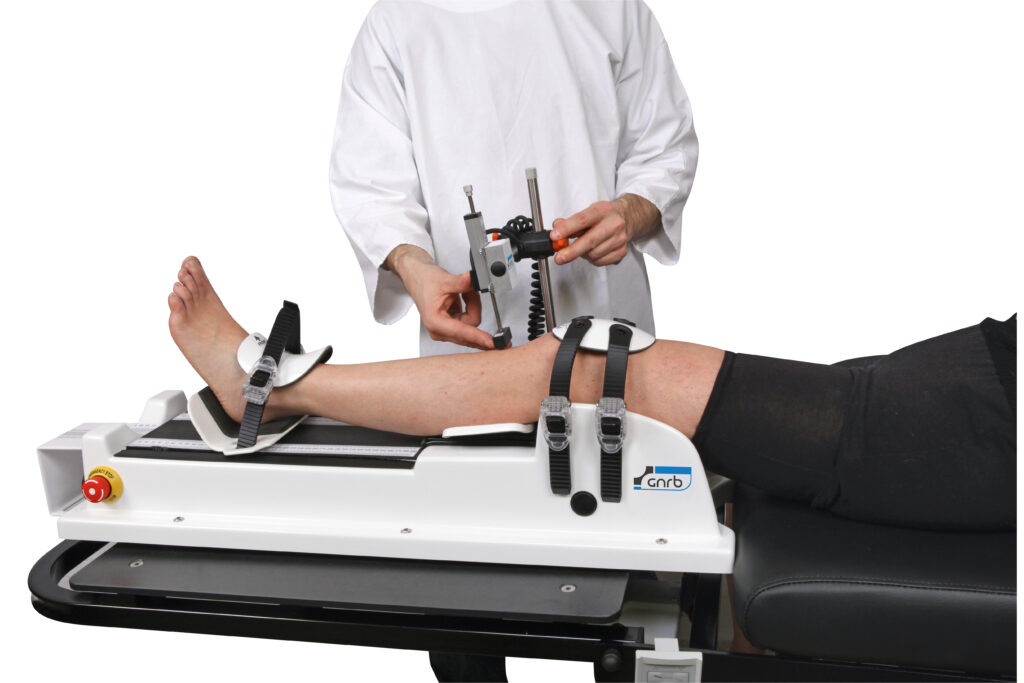
Arthrometers revolutionize the treatment of ACL injuries by offering precise measurements of knee joint laxity and the mechanical properties of the knee ligaments. This objective data facilitates the creation of personalized treatment plans that are tailored to the specific needs of each athlete.
By quantifying the extent of injury and tracking the progress of healing, these devices ensure that treatment modalities are optimally aligned with the recovery trajectory of the injured ligament. For instance, Eisenstein et al. (2016)(16) highlighted the variability in return to play (RTP) rates. The application of for individualized rehabilitation protocols to address specific athlete needs would help in this cases and would certainly increase RTP.
5.4 Enhancing Rehabilitation Through Objective Dynamic Data
The rehabilitation process following an ACL reconstruction is a critical phase that determines an athlete’s ability to return to the field. The already mentioned 2023 study “The Mechanism of Anterior Cruciate Ligament Injuries in the National Football League: A Systematic Video Review” (1) sheds light on common injury mechanisms, emphasizing the need for tailored rehabilitation strategies that address the specific risks associated with different positions and activities within the NFL. Arthrometers contribute significantly to this phase by providing continuous feedback on the knee’s functional status. This allows for real-time adjustments to the rehabilitation regimen, ensuring that exercises and therapy sessions promote healing without risking further injury. It is important to cite again the study from Nouveau – 2017 (6) in this section as it clearly indicates that personnalising rehab programs is crucial to increase the success of ACL Reconstruction surgery.
5.5 Return-to-Play Criteria
To underscore the universality of this approach, it is useful to reference findings from other sports, such as football/soccer (Click here to read our full article on ACL injuries in Soccer), where the Forelli study in 2023 (14) highlighted the critical role of continuous, objective monitoring in the rehabilitation process, emphasizing that the principles of precision and personalization in post-surgery rehab are universally applicable across sports. This cross-disciplinary insight reinforces the concept that advancements in sports medicine, including the use of arthrometers, are beneficial beyond the context of American football, providing valuable lessons in the management of ACL injuries.
Determining the right moment for an athlete to return to play post-ACL reconstruction is perhaps one of the most challenging decisions faced by sports medicine professionals. Traditional methods rely heavily on subjective assessments and predefined timelines, which may not accurately reflect an individual athlete’s recovery. Arthrometers address this challenge by offering objective criteria for return-to-play decisions. For instance, by comparing the knee stability measurements pre-injury and post-rehabilitation, practitioners can make evidence-based judgments on whether the athlete’s knee has regained sufficient function to withstand the rigors of NFL gameplay.
VI. Future Directions in ACL Injury Management
The landscape of Anterior Cruciate Ligament (ACL) injuries prevention, diagnosis, and treatment within the National Football League (NFL) is poised for significant evolution, driven by technological advancements and evolving sports medicine practices. As we look towards the future, the integration of innovative diagnostic tools and rehabilitation technologies promises to redefine our approach to ACL injury management.
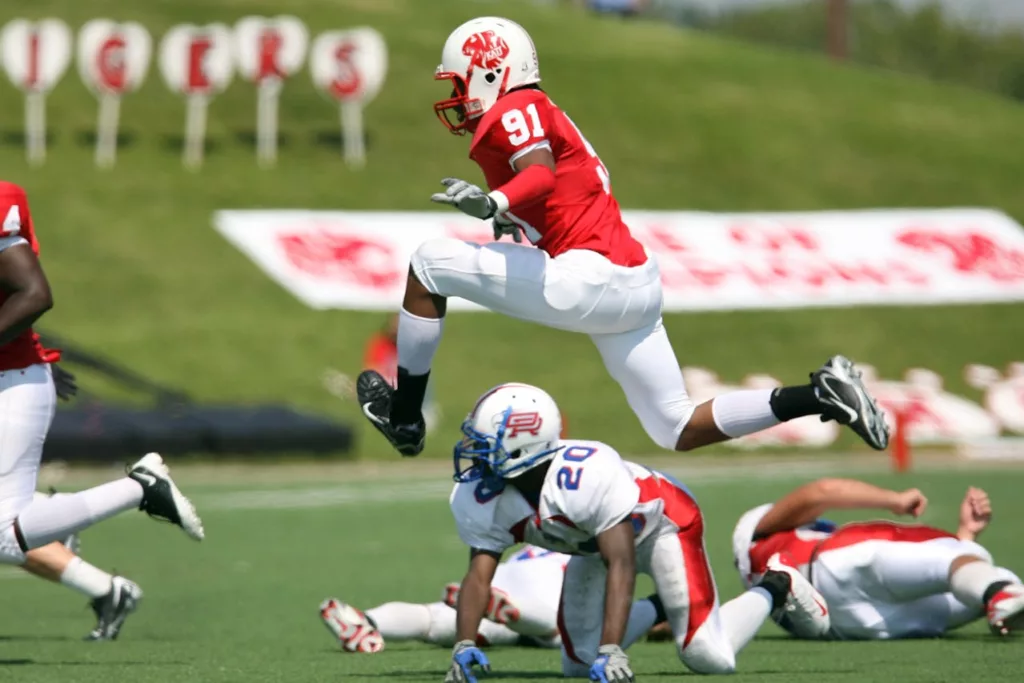
6.1 Innovations in Diagnostic Arthrometry
A pioneering development in this domain is the introduction of DYNEELAX®, the first device in the world applying rotation to the knee in a manner that closely mimics the natural movements and stresses experienced by athletes during play. This capability, combined with its translation measurements, offers a groundbreaking approach to diagnosing ACL injuries with unparalleled precision. The objective results provided by DYNEELAX® represent a significant leap forward in our ability to assess and understand the complexities of knee injuries, offering a solid foundation for tailored rehabilitation strategies.
6.2 Research and Development in ACL Injury Management
The potential of DYNEELAX® extends beyond diagnostics; it signals a new era in ACL reconstruction surgery research. The device’s unique ability to analyze knee rotation and translation simultaneously offers insights into how grafts can be optimized to mimic the native ACL more closely. This research is crucial, as it supports the development of surgical techniques and materials that promise to improve patient outcomes significantly. We are on the cusp of developing a module that applies both rotation and translation to the knee, enhancing our understanding of knee dynamics and the interplay between different types of knee movements.
6.3 The Future of ACL Grafts
The insights gained from advanced arthrometry research, particularly in studying the rotational forces exerted on the knee, are instrumental in guiding the evolution of ACL grafts. By understanding these dynamics, we can engineer grafts that not only replicate the native ACL’s structural properties but also its functional behavior under various physical stresses. This research trajectory, powered by devices like DYNEELAX®, holds the promise of making ACL reconstructions more durable, natural, and conducive to a full return to athletic performance.
6.4 The Importance of Ongoing Research
The advancement of ACL injury management in the NFL and beyond depends on our commitment to ongoing research and development. The exploration of new diagnostic modalities, coupled with innovative treatment methodologies, is essential in elevating the standard of care for athletes. Devices like DYNEELAX® play a pivotal role in this journey, offering objective data that enhance our understanding of knee mechanics and the effectiveness of different treatment approaches.
The future of ACL injury management in the NFL is bright, with technological innovations like DYNEELAX® leading the charge. By embracing these advancements and supporting continued research, we can anticipate a future where ACL injuries no longer spell the end of an athlete’s career but rather a challenge to be overcome with precision, understanding, and confidence. The journey towards more native-like ACL reconstructions is just beginning, and the insights we gain today will pave the way for the breakthroughs of tomorrow.
VII. Case Studies - Additional Arthrometer Scientific Reviews
7.1 Pre-Operative Clinical Validation
The section begins by underscoring the importance of precise and reliable pre-operative assessments in ACL reconstruction surgeries. It emphasizes the role of advanced diagnostic tools, particularly the DYNEELAX® and GNRB® arthrometers, in enhancing the accuracy of knee injury evaluations. These technologies represent significant improvements over traditional methods, offering clinicians a comprehensive and objective analysis critical for optimal surgical planning and outcomes.
7.1.1 Automated Anterior/Posterior Tibial Translation Analysis:
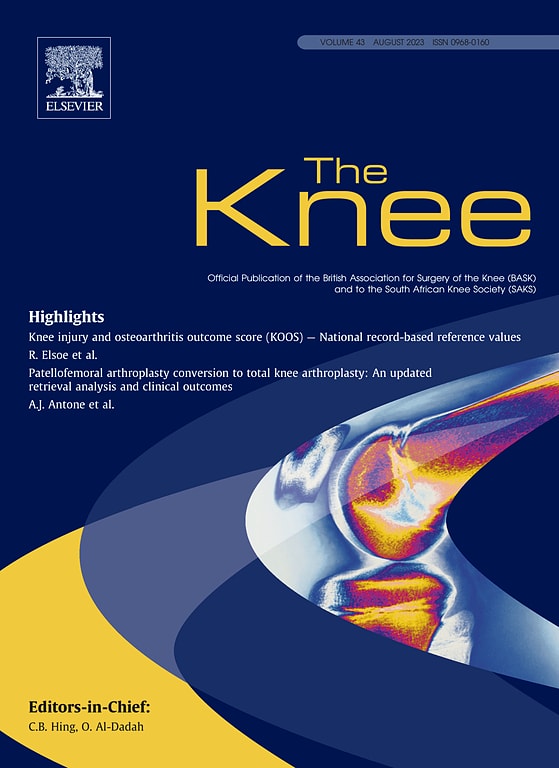
The GNRB® robotic arthrometer, an advancement over manual methods like the Lachman test, offers precise, consistent measurements for ACL and PCL diagnostics. It overcomes the subjectivity of manual tests by applying uniform force and measuring tibial translation.
Studies validating the GNRB®:
- 2023, Théo Cojean et al.(5): Demonstrated GNRB®’s higher sensitivity (73.77%) compared to MRI (29.51%) in detecting partial ACL tears.
- 2022, Miha Magdič et al.(12): Confirmed good intra-rater reliability of the GNRB® in measuring knee anterior laxity.
- 2015, Klouche et al.(10): Proved GNRB®’s diagnostic accuracy in identifying complete ACL tears.
- 2017, Jenny et al.(19): Validated GNRB® for measuring anterior tibial translation.
- 2022, Kayla Smith et al.(11): Highlighted GNRB®’s reliability in assessing ACL stiffness and laxity.
- And Many more…
7.1.2 Medial/Lateral Tibial Rotation Assessments:
The DYNEELAX® arthrometer is a significant development for measuring translation & rotational stability, surpassing the pivot shift test’s subjective limitations.
It provides precise assessments of medial and lateral knee rotation and extends to analyze the ACL, the PCL, the Anteromedial (AM), Posterolateral (PL), Anterolateral (AL), and Posteromedial (PM) corners of the knee. It should be noted that all the studies of the GNRB can also be applied to the DYNEELAX® because GNRB® technology has been incorporated in the DYNEELAX®.
Studies supporting DYNEELAX®‘s Rotation Analysis (We focus on rotation assessments here as translation has just been put forward with the GNRB®):
- 2014, Mouton et al.(20): Emphasized the importance of combining anterior and rotational laxity measurements.
- 2015, Mouton et al.(21): Validated the combined measurement approach.
- 2016, Nicolas Ruiz et al.(22): Explored the ACL’s and anterolateral structures’ roles in knee rotational dynamics.
- 2017, Senioris et al.(23): Confirmed the importance of assessing rotational laxity with anterior translation.
- 2023, Théo Cojean et al.(9): Evaluated the sensitivity, repeatability, and reproducibility of the Dyneelax.
- And Many more…
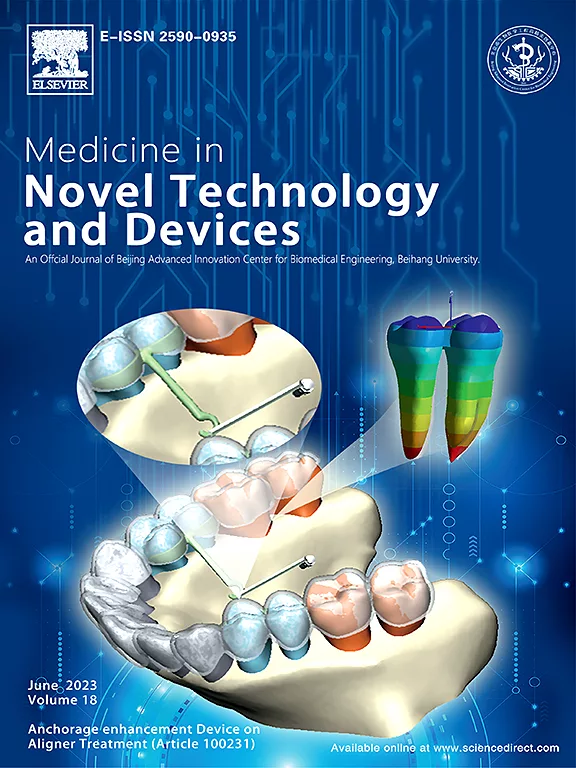
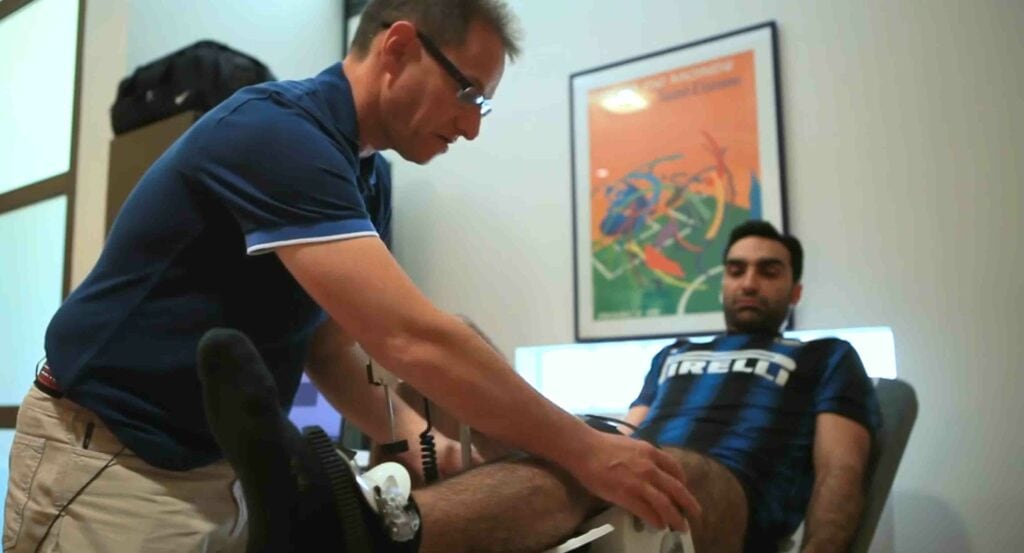
Key studies supporting the use of robotic arthrometers in rehabilitation include:
- 2016, Semay et al. (13): Demonstrated the usefulness of the GNRB in monitoring anteroposteriorlaxity after surgery, aiding in tailoring rehabilitation plans.
- 2017, Nouveau et al.(6): Highlighted the significance of understanding changes in graft compliance over time for effective rehabilitation management.
- 2023, Forelli et al.(14): Emphasized integrating arthrometer assessments into rehabilitation programs for a safer return to activities.
- 2019, Pouderoux et al.(24): Analyzed the evolution of joint laxity and graft compliance post-ACL surgery, suggesting the importance of stabilizing these factors before returning to high-impact sports.
Conclusion
In the rapidly evolving landscape of professional football, the management of Anterior Cruciate Ligament (ACL) injuries stands at a promising juncture. This article has traversed the multifaceted realm of ACL injuries within the NFL, highlighting their prevalence, impact, and the innovative strategies employed for their prevention, diagnosis, and treatment. As we have seen, the advent of advanced diagnostic tools like DYNEELAX® and the potential of simultaneous rotation and translation modules are setting new benchmarks in the precise assessment and rehabilitation of these injuries.
The journey through the current state of ACL injuries in the NFL, underscored by seminal studies and reviews, has illuminated not only the challenges these injuries pose but also the strides being made in overcoming them. From the detailed exploration of epidemiological trends to the economic and strategic impacts on teams and players, the narrative has woven through the complexities of ACL injuries with a focus on evolving sports medicine practices.
The future of ACL injury management in the NFL appears brighter than ever, with technological innovations like the DYNEELAX® arthrometer leading the charge towards more effective diagnosis and treatment strategies. This device, particularly with its groundbreaking approach to applying rotation and translation to the knee, represents a significant leap forward in our understanding and handling of knee mechanics and injuries.
As we conclude, it’s imperative to emphasize the importance of ongoing research and development in the field of sports medicine, especially in diagnostics and rehabilitation technologies. The advancements in arthrometry, exemplified by Dyneelax, not only promise enhanced accuracy in injury assessment but also pave the way for surgical techniques and rehabilitation protocols that bring us closer to replicating the native ACL’s functionality.
The integration of comprehensive injury management protocols, incorporating advanced diagnostic tools and tailored rehabilitation programs, is crucial for the NFL. It ensures not just the health and longevity of the players but also the competitive balance and financial health of the teams. As we look ahead, the continued collaboration between sports medicine professionals, researchers, and technology developers will undoubtedly yield even more innovative solutions that will further revolutionize ACL injury management in professional sports. The commitment to leveraging these innovations, supporting cutting-edge research, and adopting best practices in injury prevention and management will undoubtedly enhance player safety, optimize recovery outcomes, and ensure that the athletes can continue to perform at the highest levels with confidence and security.
The future of ACL injury management in the NFL is bright, with technological innovations like DYNEELAX® leading the charge. By embracing these advancements and supporting continued research, we can anticipate a future where ACL injuries no longer spell the end of an athlete’s career but rather a challenge to be overcome with precision, understanding, and confidence. The journey towards more native-like ACL reconstructions is just beginning, and the insights we gain today will pave the way for the breakthroughs of tomorrow.
Medical References (Click DOI for link)
- Palmieri-Smith, R. M., Mack, C. D., Brophy, R. H., Owens, B. D., Herzog, M. M., Beynnon, B. D., Spindler, K. P., & Wojtys, E. M. (2021). Epidemiology of Anterior Cruciate Ligament Tears in the National Football League. The American Journal of Sports Medicine, 49(7), 1786-1793. DOI: 10.1177/03635465211010146
- Allahabadi, S., Gatto, A. P., & Pandya, N. K. (2022). ACL Tears in the National Football League From 2013 to 2020: Analysis of the 2020 Season After Delays and Schedule Changes From the Early COVID-19 Pandemic Relative to Prior Seasons. Orthopaedic Journal of Sports Medicine, 10(2), 23259671221076045. DOI: 10.1177/23259671221076045
- Schick, S., Cantrell, C. K., Young, B., Mosher, Z., Ewing, M., Elphingstone, J. W., Brabston, E., Ponce, B. A., & Momaya, A. M. (2023). The Mechanism of Anterior Cruciate Ligament Injuries in the National Football League: A Systematic Video Review. Cureus, 15(1), e34291. DOI: 10.7759/cureus.34291
- Dodson, C. C., Secrist, E. S., Bhat, S. B., Woods, D. P., & Deluca, P. F. (2016). Anterior Cruciate Ligament Injuries in National Football League Athletes From 2010 to 2013: A Descriptive Epidemiology Study. Orthopaedic Journal of Sports Medicine, 4(3), 2325967116631949. DOI: 10.1177/2325967116631949
- Cojean T, Batailler C, Robert H, Cheze L. (2023). GNRB® laximeter with magnetic resonance imaging in clinical practice for complete and partial anterior cruciate ligament tears detection: A prospective diagnostic study with arthroscopic validation on 214 patients. Knee, 42, 373-381. DOI: 10.1016/j.knee.2023.03.017
- Nouveau, S., Robert, H., Viel, T. (2017). ACL Grafts Compliance During Time: Influence of Early Solicitations on the Final Stiffness of the Graft after Surgery. Journal of Orthopedic Research and Physiotherapy, 3(1), 035. DOI: 10.24966/ORP-2052/100035
- Mody, K. S., Fletcher, A. N., Akoh, C. C., & Parekh, S. G. (2022). Return to Play and Performance After Anterior Cruciate Ligament Reconstruction in National Football League Players. Orthopaedic Journal of Sports Medicine, 10(3), 23259671221079637. DOI: 10.1177/23259671221079637
- Stuhlman, C. R., Owens, C. J., Samuelson, E. M., Vermillion, R. P., Shermansky, M. D., King, K. B., & Connor, P. M. (2019). Recurrent Anterior Cruciate Ligament Tears in the National Football League: A Case-Control Study. Orthopaedic Journal of Sports Medicine, 7(12), 2325967119891413. DOI: 10.1177/2325967119891413
- Cojean, T., Batailler, C., Robert, H., Cheze, L. (2023). Sensitivity repeatability and reproducibility study with a leg prototype of a recently developed knee arthrometer: The DYNEELAX®. Medicine in Novel Technology and Devices, 19, 100254. DOI: 10.1016/j.medntd.2023.100254
- Klouche S, Lefevre N, Cascua S, Herman S, Gerometta A, Bohu Y. (2015). Diagnostic value of the GNRB® in relation to pressure load for complete ACL tears: A prospective case-control study of 118 subjects. Orthopaedics & Traumatology: Surgery & Research, 101(3), 297–300. DOI: 10.1016/j.otsr.2015.01.008
- Smith K, Miller N, Laslovich S. (2022). The Reliability of the GNRB® Knee Arthrometer in Measuring ACL Stiffness and Laxity: Implications for Clinical Use and Clinical Trial Design. Int J Sports Phys Ther, 17(6), 1016-1025. DOI: 10.26603/001c.38252
- Magdić M, Gošnak Dahmane R, Vauhnik R. (2023). Intra-rater reliability of the knee arthrometer GNRB® for measuring knee anterior laxity in healthy active subjects. Journal of Orthopaedics. DOI: 10.1016/j.jor.2023.03.016
- Semay, B., Rambaud, A., Philippot, R., Edouard, P. (2016). Evolution of the anteroposterior laxity by GnRB at 6 9 and 12 months post-surgical anterior cruciate ligament reconstruction. DOI: 10.1016/j.rehab.2016.07.045
- Forelli F, Le Coroller N, Gaspar M, et al. (2023). Ecological and Specific Evidence-Based Safe Return To Play After Anterior Cruciate Ligament Reconstruction In Soccer Players: A New International Paradigm. IJSPT. Published online April 2, 2023. DOI: 10.26603/001c.73031
- Shah, V. M., Andrews, J. R., Fleisig, G. S., McMichael, C. S., & Lemak, L. J. (2010). Return to play after anterior cruciate ligament reconstruction in National Football League athletes. The American Journal of Sports Medicine, 38(11), 2233-2239. DOI: 10.1177/0363546510372798
- Manoharan, A., Barton, D., Khwaja, A., & Latt, L. D. (2021). Return to Play Rates in NFL Wide Receivers and Running Backs After ACL Reconstruction: An Updated Analysis. Orthopaedic Journal of Sports Medicine, 9(1), 2325967120974743. DOI: 10.1177/2325967120974743
- Bakshi, N. K., Khan, M., Lee, S., Finney, F. T., Stotts, J., Sikka, R. S., & Bedi, A. (2018). Return to Play After Multiligament Knee Injuries in National Football League Athletes. Sports Health, 10(6), 495-499. DOI: 10.1177/1941738118768812
- Eisenstein, E. D., Rawicki, N. L., Rensing, N. J., Kusnezov, N. A., & Lanzi, J. T. (2016). Variables Affecting Return to Play After Anterior Cruciate Ligament Injury in the National Football League. Orthopaedic Journal of Sports Medicine, 4(10), 2325967116670117. DOI: 10.1177/2325967116670117
- Jenny J-Y, Puliero B, Schockmel G, Harnoist S, Clavert P. (2017). Experimental validation of the GNRB® for measuring anterior tibial translation. Orthopaedics & Traumatology: Surgery & Research. Received: 7 October 2016, Accepted: 30 December 2016 DOI: 10.1016/j.otsr.2016.12.011
- Mouton, C., Seil, R., Meyer, T., Agostinis, H., Theisen, D. (2015). Combined anterior and rotational laxity measurements allow characterizing personal knee laxity profiles in healthy individuals. Knee Surgery, Sports Traumatology, Arthroscopy, 23, 3571-3577. DOI: 10.1007/s00167-014-3244-6.
- Mouton, C., Theisen, D., Meyer, T., Agostinis, H., Nührenbörger, C., Pape, D., Seil, R. (2015). Combined anterior and rotational knee laxity measurements improve the diagnosis of anterior cruciate ligament injuries. Knee Surgery, Sports Traumatology, Arthroscopy, 23, 2859-2867. DOI: 10.1007/s00167-015-3757-7
- Ruiz, N., Filippi, G.J., Gagnière, B., Bowen, M., Robert, H.E. (2016). The Comparative Role of the Anterior Cruciate Ligament and Anterolateral Structures in Controlling Passive Internal Rotation of the Knee: A Biomechanical Study. DOI: 10.1016/j.arthro.2016.02.017
- Senioris, A., Rousseau, T., L’Hermette, M., Gouzy, S., Duparc, F., Dujardin, F. (2017). Validity of rotational laxity coupled with anterior translation of the knee: A cadaveric study comparing radiostereometry and the Rotab®. DOI: 10.1016/j.knee.2017.01.009
- Pouderoux, T., Muller, B., Robert, H. (2019). Joint laxity and graft compliance increase during the first year following ACL reconstruction with short hamstring tendon grafts.. DOI: 10.1007/s00167-019-05711-z




